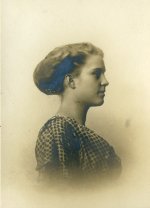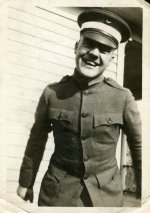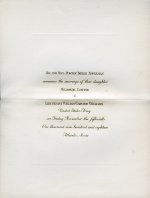
III: Married by Choice and With Passion
The story of the courtship between Mildrede and William Carleton Williams is difficult to tell in any detail because they were too active in their respective lives to leave many written records, and in any event they were more interested in dancing with each other than in writing letters. The problem is further complicated by the four year difference in their ages.
Given the conventions of that time, and knowing that Mildrede was an extremely attractive and more than a bit precocious young woman, there was nothing particularly unusual in a romantic attraction between a sought-after senior male and a seeking-after freshman girl. But once Billy graduated, he was off into the wider world, and hence we do not know how often, or for how long, they saw each other during the next few years.
By all accounts, Mildrede was a young woman compounded of brimstone and archangel. She could apparently do the Charleston or the Black Bottom in ways that fuzzed the minds of young men into proposals of engagement (of one kind or another), and then say - all wide-eyed innocence - that she really preferred to waltz. And Billy was a charming sports hero (particularly in baseball). One of their oldest and closest friends remarked many years later: "Oh, all of us were crazy about him. When I danced with him my head would swirl. As they say nowadays, I just came unglued."
All well and good. We can imagine a romance of the ages. But Billy was busy establishing himself as heir apparent to the great tradition of farming and politics that his grandfather and father had established. The Williams family had husbanded the rich land about DeKalb, Illinois, since before the Civil War. Billy's father, William Carr (born 1864), moved on to Iowa and in 1889 married Hanna Milward Turner (born 1864), a woman sustaining an equally impressive agricultural and public background. They established a profitable homestead a bit north of Atlantic and quickly became known as "W.C." and "Milly."
Their style was significantly different than the one created by Ed and Amanda Hammond. For one thing, not at all incidental, their passion produced six sons and one daughter (who died shortly after birth to the dismay of the entire family). W.C. also concentrated on breeding superb Black Angus Cattle and the crops to feed them; and his sideline was prize-winning hogs. Both of them were political: unreconstructed northern Democrats who fought hard against the policies of the Republicans - especially concerning railroads and banks. He did not literally keep his money under the mattress or in the hay loft, but he did not lose much money in the Crash of 1929-1931.
W.C. was an intelligent farmer and a dedicated citizen who died at 86 while plowing a field with four horses and plowshares that he had a blacksmith make to his own specifications. The horses stood quietly in the field until members of the family came to take W.C. home. His cattle won as many prizes as either Hammond cream or Appleman dogs. He loved and respected his wife: not just through the passion, but by encouraging her to paint - on porcelain and wood and canvas - and otherwise exercise her artistic talents. Along the way he became the first Democrat postmaster of Atlantic.
There is no record of why W.C. picked Billy, neither the oldest nor the youngest son, to sustain the farming tradition. Perhaps it was simply that Billy had the touch. That old friend who remarked that he could make one's head swirl did offer a bit of testimony that supports that interpretation. "Oh, when you were dancing with him he would just move his fingers a bit in the small of your back and you would go any place he wanted you to go." According to the two brothers who knew him best, Billy liked to work the farm, talk with the animals: "He once said he wanted to go off to the stock yards in Omaha, Nebraska, and make a million." And he did indeed spend the summer after graduation from high school on the bottom rung of that ambition.
Well, almost a summer. W.C. ordered him home to show cattle in the late summer fairs, and then sent him off to Iowa State College to learn the finer skills of animal husbandry. For its time it was a very special act. W.C. seems to have had as good an eye for people as for cattle. At the end of his second year, Billy was picked by Iowa State to show prize cattle in Canada. He was there winning prizes when the United States entered World War I.
Hence it was difficult to see how Billy saw much of Mildrede after his graduation from high school. Perhaps during the summers; but one of those times she was off at school at the Indianapolis Conservatory of Music. Then she did special work to qualify to teach grade school. She was good: she taught five months in Atlantic, was then hired by a rural school district and finally recommended for a permanent job in Atlantic.
It is more than a bit mysterious. Maybe one just has to break free of the modern idiom of sequential marriages interrupted by casual affairs. The more one reads what record survives, and ponders on the stories told by their friends, the more one is driven to conclude that it was an example of what used to be called "The Grand Passion."
One of his brothers wrote him in a way that captures that sense of it all. That younger brother, an extremely sensitive person, told Billy to "stay out of the war. The experience you are getting is a good foundation to run the farm. I couldn't stand it on the farm. You're the only one who is really any good at it and I think Dad figured that out a long time ago. So I've thought about it a lot. I say it would be best for you to accept Dad's offer. I am telling you to come home and watch that girl of yours."
Despite that advice, and over the sustained objection of his teachers at Iowa State, Billy left college and on October 12, 1917, enlisted in the Army Air Force. Maybe it was the appeal of adventure. Maybe it was patriotism. Maybe it was because his father was a Democrat. Maybe it was because he knew in his gut that Mildrede was not interested in marrying a farmer. In any event, he completed the course in "Military Aeronautics" at the University of Illinois on February 9, 1918, learned to fly at Kelly Field, Texas, and was assigned to active duty as "an instructor and demonstration pilot."
Many years later Mildrede remarked that she thought it could be understood by the example of Eddie Rickenbacker. "It wasn't so much Rickenbacker being an ace as it was his racing cars in Atlantic as a senior in high school." There is substance to the story. Rickenbacker did race cars in Atlantic and other towns in southwestern Iowa during that summer. And another brother tells us that Billy did hang around the pits any chance he got. Surely he was seduced by the romance and the challenge and the danger of the new technology. But Billy did go to Iowa State instead of trying to become a race car driver, so we are left in limbo.
What we do know for sure is that Billy became a superb flyer. He had the knack, including the toughness and the patience, of teaching other people to fly. He could also fly different and difficult airplanes. He had the touch. In that vein, therefore, the formal description of his duties as "a demonstration pilot" requires a bit of an explanation.
We must begin by realizing that it is difficult for contemporary Americans to realize that the United States as an industrial and a military complex did not always design and produce the best airplanes in the world. The hottest planes of World War I were built by the Germans, French, and British. Hence they were the machines used in combat. Thus a "demonstration pilot" was one who learned to master the better Allied planes and then prepare Americans to fly them on the Western Front.
As that lady said, Billy had the touch. He could fly a SPAD or a Sopwith Camel or a Nieuport as if he had been born in the cockpit. He was so good they ordered him to the front and then re-ordered him back to continue teaching others in Texas. Mildrede said he was "deeply depressed. He wanted to be an ace. He went into a state of funk for a week. But then he went back out on the flight line and did the job."
We can now translate that phrase, "demonstration pilot," into the modern idiom of test pilot. And thereby understand the day came when they uncrated and assembled the latest version of a Nieuport pursuit plane. It was Billy's job to learn and then demonstrate the superior - if tricky - characteristics of the aircraft.
The unknowing observers on the ground thought it had been a great show. Billy's superiors and compatriots who knew how to fly wanted to court-martial the mechanic who had not secured the cotter pin that held the joy stick in the universal socket. Billy successfully argued that the plane was new, that nobody really knew how it worked, and that it was unfair and pointless to put the blame on one person. There was no court-martial.
No one will ever know, and it is rather supercilious to speculate, whether or not that experience galvanized Billy's determination to marry Mildrede and remain a flyer. We do know they got married. We are back to the old-fashioned idea of The Grand Passion. That same dear friend I have quoted earlier said this: "I just don't know. She dated other men more than she had a chance to be with Billy." The friend was worldly and a bit bawdy. "Maybe they just knew it in their bones - and other places. It must have been one of those things." That is as good an explanation as any.
They did it with passion and style on November 15, 1918. Mildrede wore a stunning white gown that served to dramatize her decision to stop flirting and make a lifetime commitment. Billy was in uniform, his way of saying he was turning his back on the farm. The honeymoon went well: remember Mildrede's remark many years later, "Oh, once I'd been with him."
But after that it was not an easy time. The glamour of the war was gone, and Billy was ordered here and there until finally in 1919 he was discharged. In the meantime they were often separated, and Mildrede was always playing catch-up following him around the country.
There is a poignant letter from him to her. "There is deep sentiment attached to this day because we have been married six months and we haven't had too much time together and yet I want you to really know how happy and glad I am that I can call you my wife and hope it means just as much to you.
"I know there are many times when things seem to go wrong....our lives have changed for both of us but I try to live and be the way you want me and strive to be always a little better and do a little good.
"Above all I care for you. Remember that when I make mistakes."
But there was the problem of what one does after one has married hero, and what the hero does after he has flown the best airplanes in the world. It takes some doing to refocus and sustain The Grand Passion.
Table of Contents
- Introduction: The Name of the Lady
- II. The Voyage to An Identity
- III: Married by Choice and With Passion
- IV: The Joy of Flying
- V: Death, Depression and Recovery
- VI: Another Kind of Depression
- VII: Building Another Life
- VIII: Fulfillment - And Its Costs
- IX: Departure With Dignity




